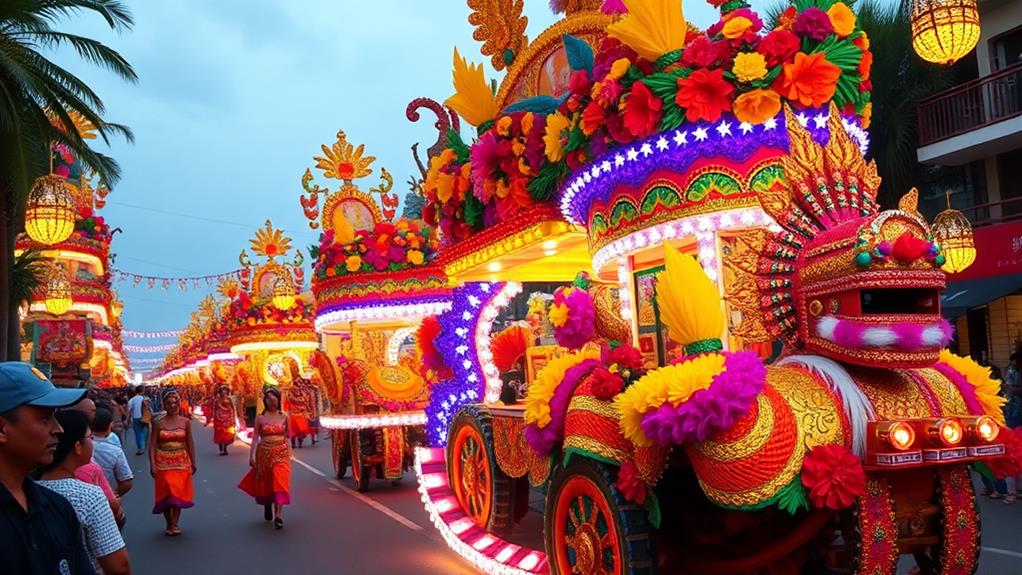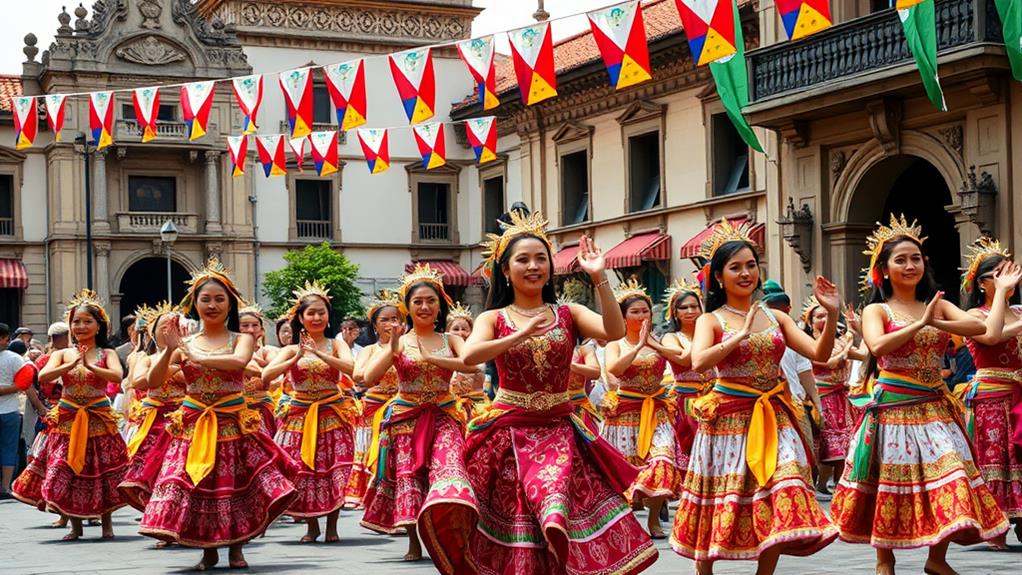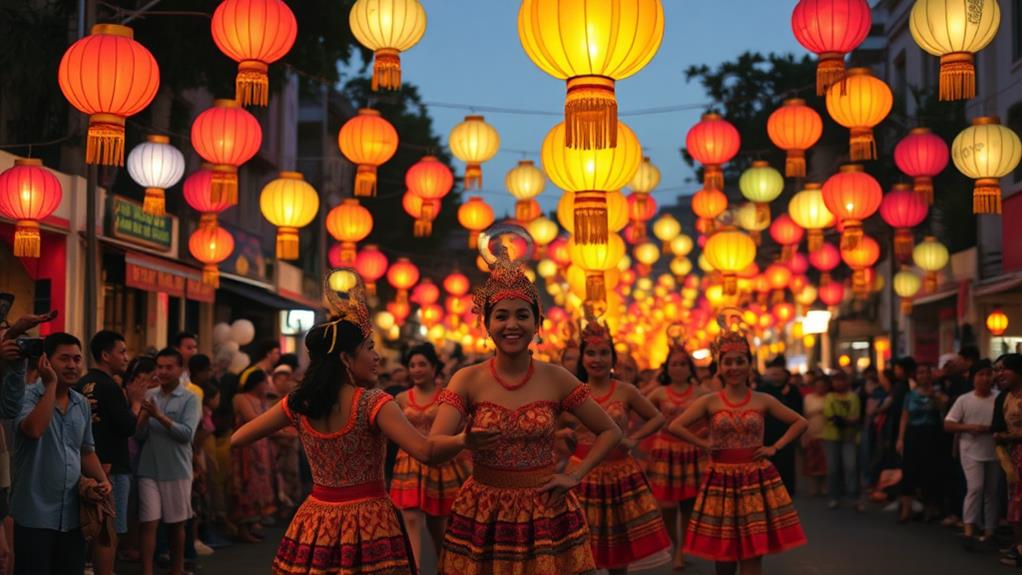The Sinulog Festival in the Philippines is a unique blend of faith, culture, and revelry.
It is held in Cebu City, where thousands of dancers in intricate costumes showcase the country's rich heritage.
During the festival, lively street parties take place, featuring a fusion of traditional and modern cuisine. This fusion allows attendees to sample a variety of local dishes, such as lechon and sinugba.
The traditional dances and stunning floats are key attractions of the festival. One notable dance is the Sinulog dance, which involves intricate footwork and rhythmic movements. The floats, on the other hand, are decorated with colorful flowers, lights, and other ornaments.
The festival has captured the hearts of travelers worldwide due to its vibrant celebration of faith and culture. It is considered a must-see spectacle for every traveler visiting the Philippines.
Vibrant Parades and Floats

The Sinulog Festival parade is a grand showcase of Filipino culture and artistic talent.
The Sinulog grand parade in Cebu features thousands of dancers dressed in intricate costumes, highlighting the Philippines' rich cultural heritage. The parade is a spectacle that showcases the country's traditions and stories through performances.
Vibrant floats are one of the main highlights of the Sinulog Festival parade.
These floats are designed with stunning artistry and creativity, featuring bright colors and creative designs that make for a visually stunning experience. The floats are a photographer's paradise, offering many opportunities to capture stunning images.
The floats' designs often reflect the country's cultural heritage and traditions.
The parade features dance troupes competing to present the best choreography.
Dance troupes compete to showcase their traditional attire and choreography, highlighting the rich artistic talent within the local community. The parade's dynamic atmosphere is filled with color and energy, reflecting Filipino traditions and stories.
The festival's lively floats and performances attract international attention, making the Sinulog Festival a significant event in Cebu that draws travelers from around the world.
The Sinulog grand parade offers an unforgettable cultural experience.
The festival provides a unique opportunity to experience Filipino culture and traditions firsthand. The parade's performances and floats leave a lasting impression, making it an event that travelers will remember long after their trip to the Philippines.
Lively Street Parties and Food
The Sinulog Festival transforms Cebu City into an immersive street party experience. Thousands of attendees gather to celebrate the festival, creating an infectious energy.
The streets are lined with food stalls, offering a variety of local delicacies such as lechon and fish balls. These dishes allow visitors to indulge in authentic Filipino cuisine.
The festival features music stages with a mix of traditional and contemporary tunes. This creates an exhilarating atmosphere that encourages attendees to dance and move.
The lively environment showcases the warmth and hospitality of the Filipino people, making both locals and tourists feel welcome.
As a food enthusiast, you'll experience a gastronomic adventure that reflects the rich flavors of Filipino culture. The festival's unique blend of music, food, and revelry makes it a must-experience for every traveler.
The Sinulog Festival's dynamic scenes and culinary delights will leave you craving more of the local food and vibrant street party experience.
Rich Cultural and Historical Significance

The Sinulog Festival holds significant cultural and historical importance, showcasing the Philippines' deep Catholic heritage. This iconic event honors Santo Niño, symbolizing the country's strong Catholic roots. The festival's origins date back to the 16th century during Spanish colonization.
The Philippines' Catholic heritage is strong, with 85% of the population identifying as Catholic. The Sinulog Festival is a prime example of this heritage, with its origins tracing back to the arrival of Spanish conquistador Miguel López de Legazpi in 1565.
The festival's cultural significance can be seen in its unique blend of pre-Hispanic and colonial influences. The Sinulog dance, which mimics the flow of the river, represents the acceptance of Christianity. This blend of cultures is a testament to the country's rich history and its ability to adapt to different influences.
The Sinulog Festival also fosters community involvement and cultural exchange. The festival brings together people from all walks of life, promoting unity and cultural understanding. The event is recognized by ASEAN, making it a significant cultural hub in the region.
The festival's cultural importance is also evident in its local delicacies and street parties. The event features traditional Filipino food, such as lechon and sinugba, which are often served during celebrations. These local delicacies are an integral part of the festival, showcasing the country's rich culinary heritage.
Stunning Religious Processions
The Sinulog Festival features stunning religious processions that showcase the locals' deep-rooted faith and traditions. These processions are a serene contrast to the festival's vibrant festivities, allowing participants and spectators to reflect on the celebration's significance.
The Fluvial Parade is a highlight of the festival, where the Santo Niño statue is carried along the waters, symbolizing the spiritual journey of faith. This procession is a unique expression of the locals' devotion to their faith.
The Sinulog Festival's religious processions can be categorized into four main types:
| Religious Procession | Description | Significance |
|---|---|---|
| Fluvial Parade | The Santo Niño statue is carried along the waters | Symbolizes the spiritual journey of faith |
| Street Procession | Participants wear traditional attire, carrying statues of saints | Honors the Santo Niño, believed to be the protector of Cebu |
| Pilgrimage | Devotees walk to the Basilica del Santo Niño, praying and singing hymns | Demonstrates the locals' deep-rooted Catholic traditions |
| Holy Mass | A special mass is held in honor of the Santo Niño | Marks the culmination of the festival's religious activities |
The Sinulog Festival's religious processions are a testament to the enduring faith and traditions of the Filipino people.
Unique Traditional Dances

The Sinulog Festival in Cebu, Philippines, features unique traditional dances that are an integral part of the celebration. These dances showcase the rich cultural heritage and artistry of the Philippines through intricate, vibrant costumes and elaborate headdresses.
The Sinulog Festival's traditional dances are truly unforgettable due to three key elements.
The festival's dance troupes competing for the best choreography results in dynamic and creative displays of talent.
Dance performances are accompanied by traditional Sinulog music, which enhances the festive atmosphere and immerses attendees in the cultural experience.
The unique dance itself mimics the flow of water, symbolizing the acceptance of Christianity and honoring the Santo Niño.
The Sinulog Festival's traditional dances create a lively environment that captivates both local and international audiences.
This infectious energy makes the festival a highlight in the Philippines.
Authentic Filipino Cuisine
Sinulog Festival: A Celebration of Authentic Filipino Cuisine
The Sinulog Festival in Cebu showcases the rich flavors of Filipino food culture through various local delicacies. The festival atmosphere enhances the gastronomic experience, allowing you to indulge in traditional meals while surrounded by lively street parties.
Traditional Filipino Dishes
Filipino cuisine is a fusion of pre-Hispanic and colonial influences. At the Sinulog Festival, you can sample traditional dishes that highlight this unique blend of flavors.
- Lechon: A whole pig slow-cooked to perfection, typically served on special occasions. The price range for Lechon at the festival is PHP 50-100.
- Adobo: A savory stew made with marinated meat or seafood, showcasing the Spanish influence on Filipino cuisine. The price range for Adobo at the festival is PHP 50-100.
Other Local Delicacies
In addition to traditional Filipino dishes, the festival also offers various local delicacies and snacks.
| Dish | Description | Price |
|---|---|---|
| Fish Balls | Crispy fried balls filled with fish paste | PHP 20-50 |
| Sinulog Sweet Treats | Assorted local desserts like turon and leche flan | PHP 50-100 |
| Batchoy | Thick noodle soup made with pork organs and crushed pork cracklings | PHP 20-50 |
Engaging with Local Vendors and Artisans
The abundance of food options during Sinulog provides a chance to engage with local vendors and artisans, deepening your appreciation for Filipino culinary traditions and hospitality.
What Makes the Philippine Festival Stand Out Among Filipino Festivities?
The Philippine festival stands out among other Filipino festivities due to its vibrant and colorful celebrations. The rich cultural heritage and traditions showcased in these events offer unique and unforgettable filipino festival experiences. From traditional dances to mouth-watering cuisine, these festivals are a must-visit for anyone wanting to immerse themselves in Filipino culture.
Immersive Community Experience

The Sinulog Festival in Cebu offers a unique immersive community experience. This experience brings you closer to the heart of Cebu's vibrant culture, making you feel like part of a larger family celebrating the Santo Niño.
The festival's community spirit is evident in the streets, where locals and visitors come together to celebrate. Locals and visitors bond over their shared excitement for the festival, creating lasting connections and memories. The Filipino people's welcoming nature makes visitors feel at home, and the immersive experience provides a deeper understanding of Cebu's culture.
You can experience the best of Cebu's community spirit in various ways. Learning from local artisans is one way to engage with the community. Interactive workshops allow you to learn about traditional crafts and techniques. For example, you can learn how to make traditional Filipino clothing or accessories.
The community also showcases its rich cultural heritage through interactive displays and exhibits. These exhibits provide a glimpse into Cebu's history and traditions. You can learn about the significance of the Santo Niño and the importance of the Sinulog Festival in Cebu's culture.
Street parties are another way to experience the community spirit. Music, dance, and food bring everyone together, creating a lively atmosphere that's hard to resist. These parties are an excellent opportunity to bond with locals and other visitors.
Festival Activities and Events
The Sinulog Festival offers a diverse range of activities and events that showcase Cebu's rich cultural heritage.
These activities include historical art exhibits, beauty pageants, and singing contests, providing entertainment throughout the month-long celebrations.
For example, the street performances feature dance troupes in traditional attire, showcasing their best choreography. This event adds to the festival's lively atmosphere and is a must-see for both locals and visitors.
The grand parade is the culmination of the festival, featuring thousands of dancers in intricate costumes and vibrant floats.
This visually stunning spectacle showcases the unity and cultural richness of the Sinulog Festival. The parade is a testament to Cebu's cultural heritage, highlighting the significance of the festival.
By participating in the festival activities and events, attendees gain a deeper appreciation for the cultural heritage of Cebu and the Sinulog Festival.
Additional events, such as fireworks displays and photo contests, enhance the festive spirit and provide excitement for attendees.
Questions and Answers
Why Is the Festival Important to the People in the Philippines?
The festival's importance to Filipinos lies in its cultural significance. This cultural significance is rooted in the fact that many festivals in the Philippines are centered around Catholic traditions and celebrations, highlighting the country's deep Catholic heritage. For instance, the Sinulog Festival in Cebu and the Ati-Atihan Festival in Kalibo are just a few examples of festivals that foster community bonding by bringing people together to celebrate their faith and showcase their resilience. These festivals also serve as a way to celebrate historical traditions, allowing Filipinos to honor their past and embody the hopes and aspirations of the community.
What Makes Philippine Festival Unique?
Unique aspects of Philippine festivals are rooted in their vibrant cultural expressions and community celebrations.
Philippine festivals are distinct due to their blend of cultural traditions and expressions. These celebrations unite people across generations, showcasing the country's rich heritage. For instance, the Ati-Atihan Festival in Kalibo, Aklan, is a prime example of a vibrant cultural expression, where participants wear colorful costumes and adorn themselves with black body paint to honor the arrival of Malay datus in the island of Panay.
These festivals also feature colorful parades and festivities that bring the community together. The MassKara Festival in Bacolod City, for example, highlights the city's resilience and gratitude with its bright and elaborate costumes, music, and street dancing. This festival promotes unity and showcases the city's heritage through its various events and activities.
What Is the Most Famous Festival in the Philippines?
The Sinulog Festival is the most famous festival in the Philippines. It takes place in Cebu City and attracts thousands of people with its vibrant dancers and cultural displays. This festival showcases the country's rich heritage and is considered one of the grandest festivals in the Philippines, rivaling other notable celebrations like the Ati Atihan Festival and Pahiyas Festival.
What Can You Say About the Festivals in the Philippines?
Festivals in the Philippines showcase the country's rich cultural heritage. Each community celebration features traditional music, dance, and costumes, weaved together to create an intricate tapestry of identity, history, and joy. For example, the Sinulog Festival in Cebu celebrates the country's Christian heritage with vibrant parades and street dancing, while the MassKara Festival in Bacolod showcases colorful masks and costumes. These festivals are an integral part of the country's identity, highlighting the unique traditions and customs of each community.